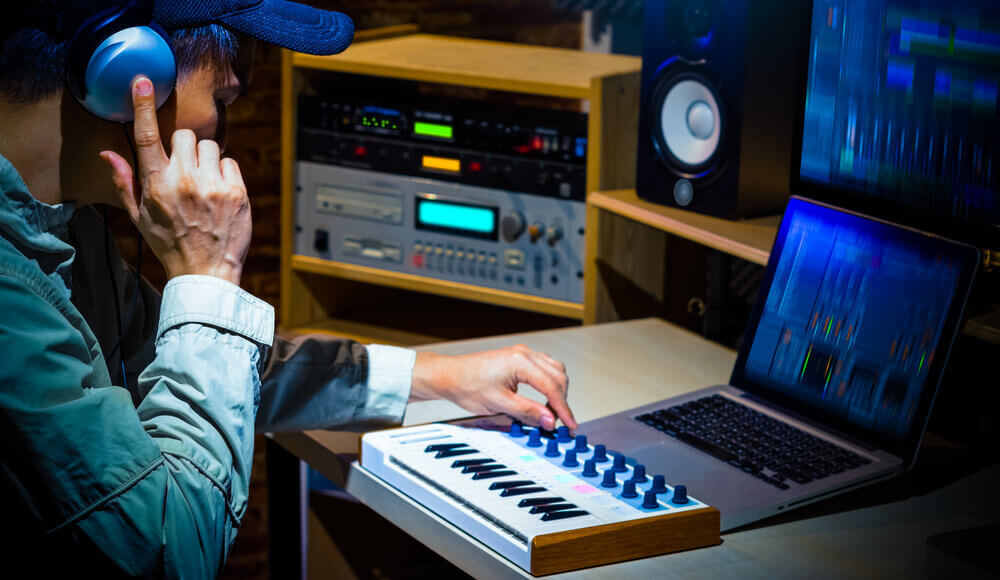
BecomeSingers is reader-supported. When you buy through links on our site, we may earn an affiliate commission. Learn More
Do you Spend time figuring out whether you need to have an audio interface to use the MIDI keyboard? The same thing occurred to me several years ago when my friend gifted me with a MIDI keyboard, and so his gift had me figuring out whether I would need an audio interface for my setup.
Of course, a MIDI keyboard is a device that you can use to send commands to any MIDI-equipped device. Thus, when you press a pad or key on the MIDI keyboard, the keyboard makes a MIDI signal. This created signal is then sent to the musical equipment to which the MIDI keyboard is connected.
On the other hand, the audio interface is also called a soundboard, a hardware device designed to convert an analog signal to digital and vice versa.
Table of Contents
Does the MIDI Keyboard Have Built-in Interface?
The USB MIDI keyboards come with a built-in MIDI interface, which means you can use your MIDI keyboard with your recording software without a dedicated audio interface. In simple terms, you won’t be needing an audio interface for your MIDI keyboard to function. Nevertheless, you will be missing out on some features afforded by audio interfaces.
First, the audio interface provides you with better audio quality for your playback. It also improves your recording music and mixing. Moreover, you’ll find it hard to find a decent set of speakers for your setup if you do not have balanced connectors on an audio interface, though you can still use quality headphones. Besides, you can plug the MIDI keyboard directly to your DAW (digital audio workstation) without an audio interface.
How to Connect Your MIDI Keyboards to DAW without an Audio Interface?
There are various ways to plug the MIDI controllers to your DAW on your computer. Below are the detailed steps on how you can connect your MIDI controllers to your PC:
1) Connecting MIDI Controllers Using USB Cables
Connecting MIDI keyboards to computer is now easy because most MIDI keyboard are capable of MIDI connection to any PC. USB is a common way of connecting MIDI keyboard to PC, and it is even more commonly used than MIDI connections. You will only use one cable with a USB connection. As such, it is convenient and easy to do.
Moreover, the USB cable connection also comes with bus power; hence, you won’t be needing an external power supply for such a connection. Some MIDI controllers feature class-compliant setup and make use of generic drivers. However, others need third-party driver software before you can make them work with the DAW.
You simply connect the USB cable to both the MIDI keyboard and your computer, and off you go. You may sometimes need to install the necessary driver software before connecting the MIDI controllers to your PC. It will be useful to check the MIDI keyboard’s user manual to know more about the firmware, driver software, and power requirements.
2) Connecting MIDI Controllers Using MIDI cables
You will find that MIDI cables work only in one direction, meaning they send data in one direction. Thus, you need to ensure that you hook the MIDI Output port to the right MIDI inputs port. Otherwise, you can never transfer MIDI data to your PC.
Using the 5-pin MIDI cable, you can connect it to the hardware’s MIDI IN port. Make sure that you connect the MIDI cable to the MIDI OUT port of your MIDI keyboard too.
Can an Audio Interface and MIDI Keyboard Work Together?
Most MIDI keyboards come with USB connectivity, which means they are engineered to connect directly to the computer via a USB connection. Nevertheless, if you want the MIDI keyboard to pass by the audio interface, your audio interface should also come with a MIDI input/output. However, not all audio interfaces come with MIDI inputs and output.
Strictly speaking, you don’t need an audio interface to make the MIDI work well. But you may experience latency issues using a USB connection. Latency refers to the obvious delay between the sound you hear and the pressing of the MIDI controller’s key.
Nevertheless, if you have an excellent USB MIDI keyboard equipped with good software, you can do away with this latency.
The audio interface can come in handy if you are using older MIDI keyboard without USB connectivity. In such a case, you can utilize an interface that features a MIDI input/output. At present, most contemporary MIDI controllers only feature USB connectivity. Some costly MIDI controllers, however, come with both USB and MIDI connectivity.
An issue will crop up if you are desirous of recording the MIDI keyboard along with the bass and guitars. Since guitars and bass signals go via an audio interface, recording the MIDI keyboard alongside bass and guitars poses a synchronization problem. In such a case, you’ll be needing an audio interface. Your MIDI keyboard should also have both MIDI IN and Out capability.
Conclusion
Audio interfaces distinguish themselves from each other by their connectivity types, numbers and inputs/outputs types, and knobs and controls. Audio interfaces are crucial to a would-be recording artist. You would need them to record your guitar, drums, bass, and vocals. Hence, selecting well your audio interface spells out the difference in the results of your recording.
Nevertheless, in the use of the MIDI controller, an audio interface is not necessary as long as your MIDI controller has USB connectivity (which it would usually have) and decent recording software. Moreover, as long as your computer can manage that direct USB connection, then you are good to go even without an audio interface.





